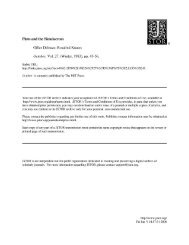research - Associated Student Government, Northwestern University
research - Associated Student Government, Northwestern University
research - Associated Student Government, Northwestern University
Create successful ePaper yourself
Turn your PDF publications into a flip-book with our unique Google optimized e-Paper software.
RESEARCHVOLUME 7, 2011-2012leptin decrease remains for a significant period of time,up to a year after the starvation event (which was 8 weeksof a low calorie diet) leptin levels were still 35% lowerthan originally (Sumithron et al. 2011). This is whatmakes is very difficult for obese people to lose weight, becauseleptin begins to serve its purpose as an indicator ofstarvation and makes the body retain weight.However, there is evidence in mice that the rodentsrespond to low leptin doses that are administered intracerebroventricularly(Jequier et al. 2002). Theserodents begin to lose weight, have decreased appetitesand increased metabolisms. This procedure overcomesthe difficulty leptin has of passing the blood brain barrierwhen blocked by triglycerides (Jequier et al. 2002).While leptin does not usually function to protect againstobesity (because it is rendered obsolete at high triglyceridelevels) this method may help overcome that issue.Lean populations have a relatively small number ofobese (BMI > 30 kg/m 2 ) and overweight (BMI: 25-30 kg/m 2 ) members, based on the IOTF criteria, in comparisonto western populations (Cole et al. 2000). The correlationsbetween anthropometric measures and leptin aresupposed to be weaker in these populations, theoreticallymaking the hormone more effective. Rather than havingreached a saturation point, it is thought that leptinlevels are less correlated, smaller and more plastic inthese populations (Kuzawa et al. 2007). Lean adolescentsin the Philippines showed correlations in both malesand females. While female leptin levels correlated withtriceps skinfolds, BMI and body weight, males were significantlycorrelated with only triceps skinfolds (Kuzawaet al. 2007). The heaviest members of the population,the top 10%, strengthened the relationship between adiposityand leptin among males. When these members ofthe population are removed from analysis, the relationshipbetween triceps skinfold and leptin declines rapidly.This is consistent with the fact that leaner males have lessleptin and a weaker correlation between triceps skinfoldand leptin (Kuzawa et al. 2007; Bribiescas 2011).In the Tsimane, no correlation was found betweenleptin levels and anthropometric levels in lean adolescentmales, but were found in females (Sharrock et al. 2008).In Ache American Indians from Paraguay leptin levelswere lower than western populations, and also showedlittle sexual dimorphism when controlling for body fat(Bribiescas et al. 2001). Leptin levels in these populationswere very low (Figure 1) and correlated with anthropometricmeasures in females but less significantly in males.Relationships between leptin levels and westernpopulations are well studied and similar across the literature(Jequier 2002). Leptin levels are lower in malesdue to the influence of testosterone (Dicker et al. 2004).Leptin levels are most strongly correlated with body fatand other measures of subcutaneous fat, in these westernpopulations (Considine et al. 1996). While leptinlevels also correlate with BMI, WHR, Waist circumference,Hip circumference, triceps skinfolds and subscapularskinfolds, the greatest relationships are with measuresof subcutaneous fat (Heffner et al. 1996). Othermeasures become less significant when regressed withmeasures of subcutaneous fat (Considine et al. 1996).Due to the nature of different fat cells, leptin levelsdiffer based on the regional deposition of fat (Minocciet al. 2000). There are three basic measures of regionalfat deposition. Subcutaneous fat directly other the skin,and can be measured by triceps skinfold thickness, subscapularskinfold thickness and hip circumference (Gibson1990, Ruhl et al. 2001, Heffner et al. 1996). Visceralfat, commonly associated with health problems such asdiabetes and heart disease, can be measured by BodyMass Index (BMI), waist circumference or Waist to HipRatio (WHR) (Ruhl et al. 2001, Staiger et al. 2003, Heffneret al. 1996). Subcutaneous fat cells are larger andsecrete more leptin, so they have a greater influence/stronger correlation with leptin (Roemmich et al. 1998,Ruhl et al. 2001). When waist circumference and waistto hip ratio are added to regression models, however,more variation is explained than with measures of subcutaneousfat alone (Ruhl et al. 2001).MethodsThe study is a cross sectional analysis of data fromthe Cebu Longitudinal Health and Nutritional Survey(CLHNS). The individual data, including all anthropometricmeasures relevant to the study were collected inthe first and every subsequent follow up survey (UNCCarolina Population Center 2011). These measuresincluded body weight, height, waist circumference andtriceps and subscapular skinfolds using standard anthropometricprocedures (Lohman et al. 1988). BMIwas calculated as a ratio of weight (kg) to height (m 2 ).The <strong>research</strong> was conducted under conditions of informedconsent and with human subject clearance fromthe IRB of the Emory <strong>University</strong> Medical School and the<strong>University</strong> of Chapel Hill, NC (Adair et al. 2010).The data being used is from the 2005 follow up fromthe offspring only. This follow up added fasting blooddrawn for CVD biomarkers and genetics (Adair et al.2010). Blood samples were taken after an overnightfast and the plasma stored for analysis in EDTA coatedtubes. The regular anthropometric measures were alsotaken. The samples were allowed to separate, were frozenand shipped on dry ice to the <strong>University</strong> of NorthCarolina at Chapel Hill for analysis using a LINCO ResearchHuman Leptin ELISA kit.The study population was 1,597 individuals fromthe CLHNS using data collected in the 2005 follow up.Only subjects with all the available anthropometricmeasures of interest and leptin data were used in theanalysis. There were 909 males and 688 females total.All pregnant females, based on follow up blood testing,were removed from the data analysis.NORTHWESTERN UNDERGRADUATE RESEARCH JOURNAL71











